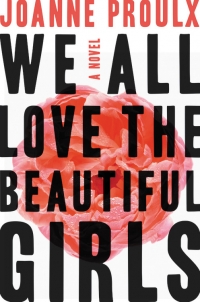We All Love the Beautiful Girls by Joanne Proulx
 Monday, August 27, 2018 at 7:13AM
Monday, August 27, 2018 at 7:13AM 
First published in Canada in 2017; published by Grand Central Publishing on August 28, 2018
We All Love the Beautiful Girls is an intense examination of an eventful year in the life of a married couple and their teenage son. The first days of January introduce two couples in their 40s playing Pictionary: Michael and Mia Slate, Peter and Helen Conrad. Michael and Mia have been married for two decades but still enjoy a vigorous (and rough) sex life, complete with a safe word that Mia never invokes. Michael and Peter are in business together. The Slates’ son, Finn, is finishing high school. The Conrads’ daughter, Frankie, has an ambiguous teenage friendship with Finn, who has a sex buddy relationship with an older girl named Jess when she isn’t with her rich boyfriend, who is the brother of Finn’s best friend. The novel is set in a prosperous community in Canada.
The drama begins in February, when Michael discovers that Peter has taken over ownership of their business by abusing Michael’s trust. The only thing that distracts Michael from the shock of discovering that betrayal is the realization that Finn is well past his curfew. In segments of the story told in believable language from Finn’s point of view, we follow Finn to a party where teenage drama and a combination of alcohol and drugs leave him upset and wasted. Finn nearly freezes to death, leading to the loss of his hand. Every word in this section of the novel conveys tension; it is completely absorbing.
Finn continues to narrate part the story from his first-person perspective while the rest of the story is told in the third person. The first-person focus on Finn lets the reader understand the family dynamic from a perspective that Finn’s self-centered father and self-pitying mother cannot provide. The story follows the characters through a number of confrontations and potentially life-altering events as they struggle to move beyond their respective crises.
To some extent, We All Love the Beautiful Girls is a relationship drama. Can the long and intense friendship between Mia and Helen survive Peter’s betrayal of Michael? Can either marriage survive? What about Finn’s friendship with Frankie and his romantic (from his perspective) relationship with Jess, who is probably engaged only because of her boyfriend’s wealth? Can Finn’s friendship with his best friend survive the fact that they betrayed each other with their careless actions?
Finn’s friends and their parents are breaking up for all the usual reasons, “like every other human being trying to survive love on this planet.” Michael hits baseballs and smokes weed with a kid who might be turning into a surrogate son, a stranger to whom he can open up, something he seems incapable of doing with Finn. For his part, Finn is convinced (with reason) that his parents don’t understand how he feels and aren’t doing enough to help him cope with his loss. Mia at least understands that having a child means loving him in difficult times — “no quitting” — but Finn’s parents struggle to find the right way to express their support.
While the novel examines characters in the context of familial and other relationships, it also probes deeply into the interiors of Michael, Mia, and Finn, each of whom must probe their own interiors, to find themselves, during the course of the novel. Michael is rooted in anger that he can’t express, that always bubbles just below the surface but threatens to manifest itself in senseless violence. Mia is feeling her age and, while flirting an old friend who represents Michael in his lawsuit against Peter, wonders if rejuvenating her sex life would rejuvenate the rest of her life. Michael and Mia can’t agree upon an approach to Finn’s disability, while Finn is understandably self-conscious, doing his best to ignore or conceal his missing hand while refusing to participate in therapy or to wear a prosthetic.
The last third of the novel brings each family member to a climactic moment, one that requires a choice to be made. The cliché is that what doesn’t kill us makes us stronger, but that isn’t always true. Finn wants to believe it, but the novel’s most powerful question is whether Finn and his parents will gain strength from or be destroyed by their losses. Some of their initial reactions to adversity might be shameful, but that only makes them human. Yet bad actions often have consequences that are more severe than intended, and people who make poor decisions, as well as their victims, must live with the resulting harm. The novel illustrates that the things we do to make ourselves feel powerful may actually weaken us by forcing us to recognize and live with the consequences of our destructive impulses.
We All Love the Beautiful Girls tells a smart and nuanced story, blending themes of love and karma with themes of pain and anger. The story balances depressing realities against hope that people can overcome their worst tendencies and can address the horrors that befall them. The story’s touching, poignant moments never feel contrived or melodramatic, although Finn’s meditations on love and Mia’s remonstrations with Michael and repeated comments about the difficulty of forgiveness and the importance of not quitting on your kids sometimes seem like a heavy-handed attempt to scream the novel’s lessons at readers who might not otherwise get it. Still, the strong characters, dramatic plot, and sharp prose easily overcome the novel’s few flaws.
RECOMMENDED
Reader Comments